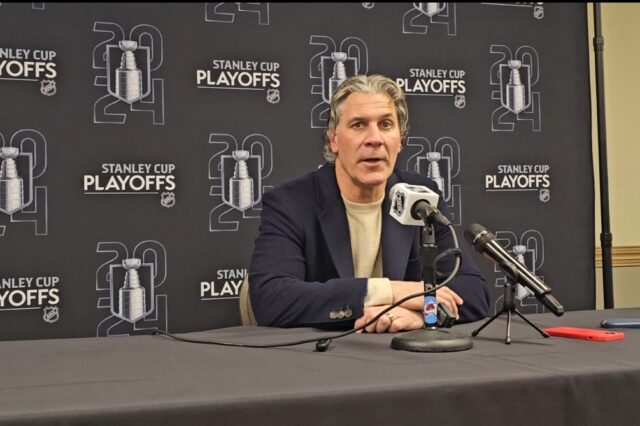This story originally appeared in Mile High Sports Magazine. Click here to read the full digital edition.
Of the 12 months on the calendar, August is supposed to be the one in which NHL general managers get to take a good, long break. The draft, free agency, unsigned players, other front-office matters – those things usually are all taken care of by Aug. 1, and the unspoken rule in hockey by then is: See you in September.
August 11 seemed like just another quiet day, therefore, around Colorado Avalanche headquarters. A 23-man roster was all set contractually for the 2016-17 season, with less than $1 million remaining under the league’s $74 million salary cap. Young, core players such as Tyson Barrie and Nathan MacKinnon had just recently signed new, long-term deals, while Avs general manager Joe Sakic and head coach Patrick Roy appeared set to return for their fourth consecutive seasons in their respective jobs.
But by the end of the business day on the 11th, the Avalanche suddenly was without a head coach. In a brief press release from an obscure public relations agency from Quebec City, Roy announced his resignation. In a hastily-arranged conference call with reporters, Sakic tried to explain just how this day could have happened, how his former teammate, friend and front-office partner could have decided to bail with only a little more than a month remaining until the start of training camp.
All the while, shocked Avalanche players and fans were left to wonder: How did we wind up here, with an organization that seems directionless again just three years after Sakic and Roy promised to restore stability and luster to the once-proud franchise?
In the wake of Roy’s stunning departure, it is fair to ask the question: Are the Avs headed right back into the ditch after seemingly having been put on the right road by Sakic and Roy in 2013? Or, as some critics have argued, are they actually just now headed to the right track with a new coach, Jared Bednar, better equipped to deal with the modern game?
It will take some time to better answer either question, but one thing seems clear: The Avs continue to be an organization grappling with how to get back to the NHL’s elite, back to the real estate that seemed their birthright when they moved to Denver from Quebec in 1995.
“I was surprised only by the timing of Roy’s resignation. He is fiercely competitive and had absolute control when he ran his junior team in Quebec. But the Avs under his direction were playing a system that was unsustainable,” said Ray Ferraro, the former NHL player and current analyst with Canada’s TSN. “They showed little inclination to change.”
As training camp neared, most everyone in the hockey world was still asking: Why did Roy quit? In his press release, Roy seemed to essentially answer the question, saying, “I have thought long and hard over the course of the summer about how I might improve this team to give it the depth it needs and bring it to a higher level. To achieve this, the vision of the coach and VP-Hockey Operations needs to be perfectly aligned with that of the organization. He must also have a say in the decisions that impact the team’s performance. These conditions are not currently met.”
So, it was a power struggle over who had the most say in personnel decisions. Roy had the added title of vice president of hockey operations, but Sakic had the final say as the general manager. Roy wanted to make certain changes, and when they weren’t made by Sakic, he bailed. Simple.
But is it really? Sakic said Roy was consulted on all personnel decisions and that he was given no indication Roy was unsatisfied with any moves he did or didn’t make over the summer. In the reporting of this story, some NHL sources painted a more nuanced picture of what happened, which all seemed to circle back to a general drifting apart of the Sakic-Roy marriage that was so full of promise in 2013.
Sakic and Roy spoke of a “partnership” upon their hire – Sakic was promoted on May 13, 2013 and hired his old netminder 13 days later – and for a while it seemed to be equal. Surely, a hire that took place so quickly had to have been thought of well in advance. Plans had to have been hatched. Visions from the start had to be, for lack of a better term, parallel.
While Sakic acknowledged that he technically had the final say on all personnel decisions, he seemed eager for Roy’s input. Although Roy said “Joe is my boss” on the day he was formally introduced as coach, everybody familiar with his history wondered how long it would be before he chafed not having full control.
“There is no way he, or anyone else for that matter, in today’s complicated system, should have total control over player acquisition,” Ferraro said.
One event that might have caused an eventual strain on Sakic’s partnership with Roy was the trade last summer that sent Ryan O’Reilly and Jamie McGinn to Buffalo for Mikhail Grigorenko and Nikita Zadorov, with other draft picks involved. The deal happened on the floor of the 2015 NHL draft in Florida, in what looked like spur-of-the-moment fashion.
“[Roy’s] fingerprints are all over that one, acquiring players he coached (Grigorenko) or knew from the Quebec League” Ferraro said.
While Grigorenko actually played well at times last season and was re-signed by Sakic, and Zadorov still has promise, the trade still has been lopsided in favor of Buffalo, where O’Reilly became an NHL All-Star. Zadorov spent much of his first season with the Avs with their farm team in San Antonio.
Roy formally talked with the press for the first time since his departure on Sept. 8 in Quebec City, during a World Cup of Hockey exhibition game. Roy said he had “no regrets” over his decision.
“The type of players and stuff like that, we didn’t necessarily agree on,” Roy said. “It goes beyond that. It was people working for the team and stuff like this that we were a little bit different.”
The inclusion of former Columbus executive Chris MacFarland as the Avs’ new assistant general manager last year is another likely factor that drove a wedge between Roy and Sakic. MacFarland was increasingly seen as Sakic’s new right-hand man, whereas before it was Roy. Over the summer, the Avs hired Nolan Pratt as an assistant coach, a former Avs defenseman and teammate of Roy’s but who had been part of the Columbus organization before with MacFarland. That move seemed to have MacFarland’s fingerprints on it (and, later, on the hiring of Bednar too). But if Roy was upset about that and over not having enough control over personnel, his words from the day he was introduced as coach contradict him.
“Joe is my boss,” Roy told reporters that day. “To answer a direct question, I would have taken this job if it were only just as coach. Working with Joe every day, coming to this rink and working with him on the decisions on how this team is going to go, I could not have asked for anything better. I don’t know how long this ride is going to be, but I can to tell you, my plan is to enjoy every minute, and I want to enjoy it with our fans.”
In the end, Roy seemed to want it both ways, and this wasn’t for the first time in his career.
We’d all seen how Roy came to Colorado in the first place, in a fit of pique against Montreal coach Mario Tremblay in a Dec. 2, 1995 game. If Roy wasn’t the No. 1 guy in goal, he could be difficult to be around. Brian Hayward, who shared goaltending duties with Montreal from 1986-90, has spoken before of the tense relationship he had with Roy. During his last year as a player, 2002-03, Roy spent a good part of his off time securing a role with the Quebec Remparts of the QMJHL that would guarantee not just a coaching position, but one of partial ownership and full control of all personnel decisions. He won a Memorial Cup his first year on the job.
Roy won the Jack Adams Award as NHL coach of the year with Colorado in 2013-14, and the Avs won their first division title since 2002-03. But the Avs slipped back below the playoff cutoff list the next season and by the end of 2015-16 Roy seemed to lose faith in his team. The fun, which he said would keep him in the job until it wasn’t there anymore, was gone.
The low point was a 4-0 home loss to Minnesota on March 29, which effectively knocked them out of playoff contention. After the second period, Roy screamed so loud in the dressing room that he could be heard well down the hallway. After that, he seemed to lose the passion and physical energy on the bench that had so marked his first two years.
“He looked exasperated, as though he was out of answers,” Ferraro said. “It appeared as though he thought his way could be the only road to respectability.”
By the end, Roy verbally threw No. 1 center Matt Duchene under the bus for celebrating a goal in a 4-0 game late in the third at home against St. Louis. He started using Calvin Pickard more instead of $5.9 million goalie Semyon Varlamov. Sources say Roy lost some faith in Varlamov’s overall mental toughness.
Still, he told Sakic and the rest of the organization he would be back for a fourth year. But by Aug. 11, after the team’s free-agent moves had been made (a C-list crew led by former University of Denver center Joe Colborne) and the rest of the roster filled in, Roy changed his mind.
There was speculation during the free-agency period that Roy wanted Sakic to sign another former player of his from the Remparts, 30-year-old Russian forward Alexander Radulov, whose talent is undeniable but whose NHL career was plagued by off-ice headlines for bad behavior. In his talk with reporters in Quebec, Roy called Radulov a “special player”, but denied that Sakic’s decision to spend his money elsewhere (on the free agents he did sign, along with rich new deals for youngsters Tyson Barrie and Nathan MacKinnon) instead of Radulov was the biggest reason he left. Clearly, though, it was a factor.
In Bednar, a journeyman minor-league defensemen as a player who found success as a coach in the Columbus system, the Avs are back to a rookie coach who promises to play more high-pressure, puck-possession hockey.
“The plan that we’re going to put in place can help elite defensemen or up-and-comers,” Bednar said, at his introductory news conference. “It’s all about support and knowing what you’re trying to do with the puck before you get there under different sets of circumstances.”
Can Bednar really get stellar results from the same core that really hasn’t changed much since Joe Sacco coached his final couple of years before leaving in 2013, and later vexed Roy much of the time?
Not many pundits seem to think so, at least for this coming season. Not one national hockey publication picked the Avs to make the playoffs in 2016-17.
The Avs last won a playoff series in 2008, against Minnesota, and have not been past the second round since 2002. Now, their Hall of Fame former player and second coming savior as coach is gone, having had enough.
For a team that used to live the seeming never-ending charmed life, the good old days seem most distant than ever.



